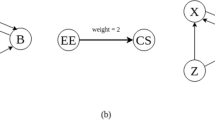Abstract
Although there are many measures of centrality of individuals in social networks, and those centrality measures can be applied to the analysis of authors’ importance in co-authorship networks, the distribution of an author’s collaborative relationships among different communities has not been considered. This distribution or extensity is an important aspect of authors’ activity. In the present study, we will propose a new measure termed extensity centrality, taking into account the distribution of an author’s collaborative relationships. In computing the strength of collaborative ties, which is closely related to the extensity centrality, we choose Salton’s measure. We choose the ACM SIGKDD data as our testing data set, and analyze the result of authors’ importance from different points of view.
Similar content being viewed by others
References
Bonacich, P. (1972), Factoring and weighting approaches to status scores and clique identification, Journal of Mathematical Sociology, 2: 113–20.
Bonacich, P. (1987), Power and centrality: A family of measures, The American Journal of Sociology, 92: 1170–1182.
Borgatti, S., Everett, M., Shirey, P. (1990), LS sets, Lambda sets and other cohesive subsets, Social Networks, 12: 337–357.
Borgatti, S., Everett, M., Freeman, L. (2002), UCINET for Windows: Software for Social Network Analysis, Analytic Technologies, Harvard, MA.
Borner, K., Dall’asta, L., Ke, W., Vespignani, A. (2005), Studying the emerging global brain: Analyzing and visualizing the impact of co-authorship teams, Complexity, 10: 57–67.
Braun, T., Glänzel, W., Schubert, R. (2001), Publication and cooperation patterns of the authors of neuroscience journals, Scientometrics, 51: 499–510.
Brin, S., Page, L. (1998), The anatomy of a large-scale hypertextual Web search engine, Proceedings of 7th International World Wide Web Conference, 101–117.
Chakrabarti, D., Faloutsos, C. (2006), Graph mining: Laws, generators, and algorithms, ACM Computing Surveys, 38: 1–69.
Freeman, L. C. (1979), Centrality in networks: I. conceptual clarification, Social Networks, 1: 215–239.
Genest, C., Thibault, C. (2001), Investigating the concentration within a research community using joint publications and co-authorship via intermediaries, Scientometrics, 51: 429–440.
Getoor, L., Diehl, C. (2005), Link mining: A survey, ACM SIGKDD Explorations Newsletter, 7: 3–12.
Hou, H., Kretschmer, H., Liu, Z. (2008), The structure of scientific collaboration networks in Scientometrics, Scientometrics, 75: 189–202.
Kretschmer, H. (2004), Author productivity and geodesic distance in bibliographic co-authorship networks, and visibility on the Web, Scientometrics, 60: 409–420.
Kleinberg, J. (1999), Authoritative sources in a hyperlinked environment, Journal of the ACM, 46: 604–632.
Liu, X., Bollen, J., Nelson, M., Sompel, H. (2005), Co-authorship networks in the digital library research community, Information Processing and Management, 41: 1462–1480.
Newman, M. (2001a), Scientific collaboration networks. I. Network construction and fundamental results, Physical Review E, 64.
Newman, M. (2001b), Scientific collaboration networks. II. Shortest paths, weighted networks, and centrality, Physical Review E, 64.
Newman, M. (2003), The structure and function of complex networks, SIAM Review, 45: 167–256.
Salton, G., Mcgill, M. (1983), Introduction to Modern Information Retrieval, McGraw-Hill, N.Y.
Tutzauer, F. (2007), Entropy as a measure of centrality in networks characterized by path-transfer flow, Social Networks, 29: 249–265.
Wasserman, S., Faust., K. (1994), Social Network Analysis. Methods and Applications, Cambridge University Press, Cambridge.
Yin, L., Kretschmer, H., Hanneman, R., Liu, Z. (2006), Connection and stratification in research collaboration: An analysis of the COLLNET network, Information Processing and Management, 42: 1599–1613.
Yoshikane, F., Nozawa, T., Tsuji, K. (2006), Comparative analysis of co-authorship networks considering authors’ roles in collaboration: Differences between the theoretical and application areas, Scientometrics, 68: 643–655.
Author information
Authors and Affiliations
Corresponding author
Rights and permissions
About this article
Cite this article
Lu, H., Feng, Y. A measure of authors’ centrality in co-authorship networks based on the distribution of collaborative relationships. Scientometrics 81, 499–511 (2009). https://doi.org/10.1007/s11192-008-2173-x
Received:
Published:
Issue Date:
DOI: https://doi.org/10.1007/s11192-008-2173-x




